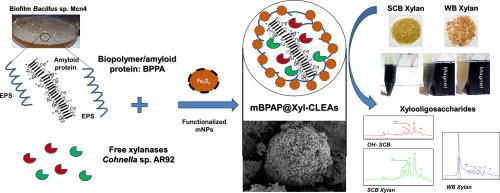Reactive & Functional Polymers ( IF 5.1 ) Pub Date : 2020-06-14 , DOI: 10.1016/j.reactfunctpolym.2020.104676 Johan S. Hero , Andrés H. Morales , Nora I. Perotti , Cintia M. Romero , M. Alejandra Martinez

|
Cross-Linked Enzyme Aggregates (CLEAs) technologies for enzyme immobilization are influenced by mass transference problems as the degree of molecular crosslinking achieved strongly affects the enzyme exposure to the substrates. Therefore, this work seeks to improve the accessibility of high molecular weight substrates by using macromolecular cross-linkers to the synthesis of a xylanolytic biocatalyst. After confirming that commercial polymers used as macromolecular cross-linkers significantly upgraded the xylanase activity from a crude preparation, a novel biopolymer/amyloid protein complex (BPAP) extracted from a microbial biofilm was used producing a remarkable recovery (83%) of the enzyme activity.
A response surface methodology was applied to contrast the features of a previously developed biocatalyst with glutaraldehyde (GA@Xyl-CLEAs) and a novel one synthesized with BPAP combined with functionalized magnetic nanoparticles: mBPAP@Xyl-CLEAs. It was observed that the crosslinking agent used was the factor that most affected the enzyme activity. Also, the mBPAP system showed a similar and higher hydrolytic activity than those synthesized with GA, which was not affected by the mNPs/protein ratio. Finally, the mBPAP@Xyl-CLEAs were successfully tested for xylooligosaccharides production from agroindustrial-derived substrates, making this technology a promising practice to obtain green and suitable biocatalysts.
中文翻译:

通过使用新型高分子交联剂,改进用于农业工业副产品生物转化的磁性Xyl-CLEAs技术的开发
酶固定化的交联酶聚集体(CLEA)技术受传质问题的影响,因为实现的分子交联程度强烈影响酶与底物的接触。因此,这项工作试图通过使用大分子交联剂来合成木聚糖分解生物催化剂来改善高分子量底物的可及性。在确认用作高分子交联剂的商业聚合物显着提高了原油制品中的木聚糖酶活性后,使用了从微生物生物膜中提取的新型生物聚合物/淀粉样蛋白复合物(BPAP),可显着恢复酶活性(83%) 。
应用响应表面方法对比了以前开发的戊二醛生物催化剂(GA @ Xyl-CLEAs)和用BPAP合成的新型催化剂与功能化磁性纳米粒子的特性:mBPAP @ Xyl-CLEAs。观察到使用的交联剂是最影响酶活性的因素。同样,mBPAP系统显示出比用GA合成的类似和更高的水解活性,不受mNPs /蛋白质比的影响。最后,成功地测试了mBPAP @ Xyl-CLEAs从农用工业衍生的底物中产生的木寡糖,使该技术成为获得绿色且合适的生物催化剂的有前途的实践。



























 京公网安备 11010802027423号
京公网安备 11010802027423号